What is the NATURE of the suture, what is their STRUCTURE, how to IMPLANT them?
We will see in this chapter that the concept of suture, so easy to imagine, in fact covers various concepts and sometimes quite complex ones. We will try to explain as clearly as possible, with the help of schemes.
Let's start from their nature (the material) and structure (form).
Then come the various sites.
Suture NATURE: permanent or absorbable?
-
The permanent suture
The permanent suture are chosen for their biochemical neutrality, authorizing their final presence in the tissue, which is inconceivable and justified only if it has a long-term effectiveness.
They are made of polypropylene for the major part, but the most recent ones are more complex.
The material is well known and has been used for over half a century for permanent deep sutures (heart sutures). - The permanent suture can remain permanently in the tissues without disturbing them, because of their excellent biocompatibility. Their biochemical neutrality makes their implants very safe and persistent, which allows a long-term vision of this technique and its effects.
If nothing in their structure (pointed end) or in their location (too superficial position) is aggressive for surrounding tissues or solicit their mobilization (facial movement), these suture have a perfect fitting and stability. In addition, if for any reason this should be done, they could be removed.
There is a suspicion among the public against any "foreign body", which is unable to withstand the evidence that the biocompatible materials are multiplying, invading our therapeutic area, and this for a better quality of people’ life. We are always surprised at the number of outsourced solutions fit to repair our tissues and our functions. Why not our look?

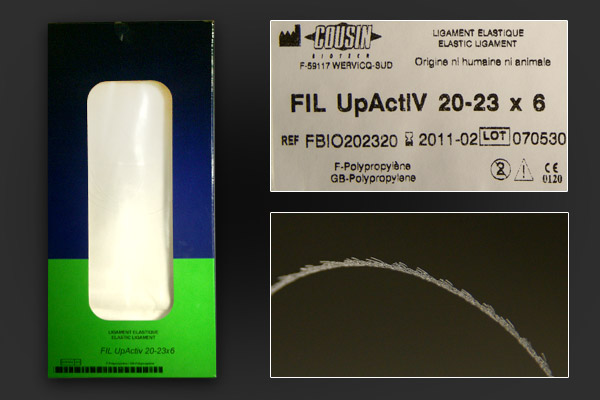
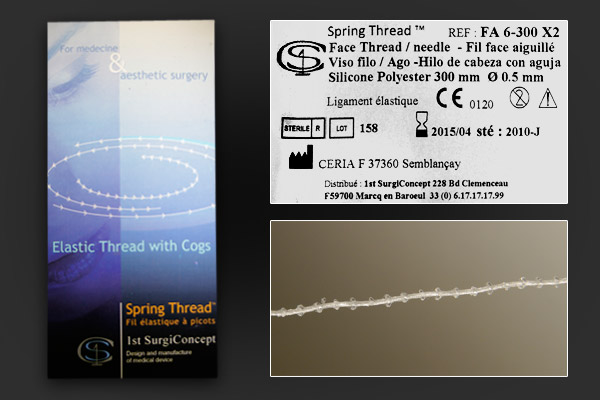
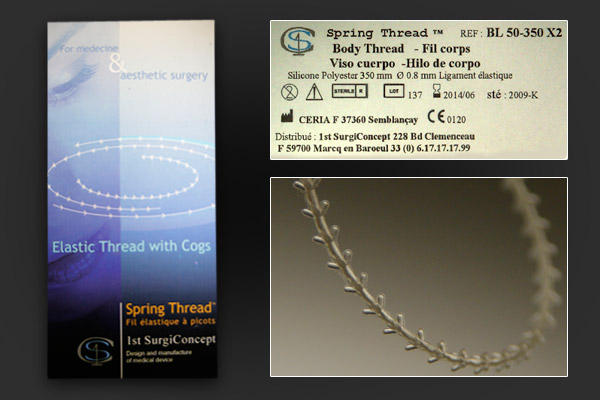
CHART of the permanent threads nature: (marketing chronology)
Material
Structure
Ø
lenght
Notch/ cm
APTOS
polypropylene
monofilament
0,3 mm
12&25 cm
3 n/cm
SILHOUETTE SUTURE
polypropylene
+ ac. Glycolique + ac. polylactique
monofilament
+ cones
0,2 mm
0,9 mm
cm
0,5 n/cm
UPACTIV
polypropylene
microfilaments
0,3mm
30 cm
SPRING THREAD
polyester
silicone sheath
monofilament
0,5mm
30 cm
16 n/cm
-
Absorbable suture
Absorbable suture are made of a mixture of glycolic acid and polylactic acid, being absorbed within a year, which makes of the implants of a very different interest.
Their shelf life is more limited, but they can however be renewed without limit.
Shorter, wrongfully neutral and with an almost theoretical notching, they owe their success to the fact that they reassure those who do not support the idea of hosting a permanent suture. Considering their low barbed structure, they may not have the effect of suspension, but thanks to their biochemical nature, they can be credited with revitalizing action, which is very different and insufficient for our aim. - The absorbable suture (HAPPYLIFT ® and their set version ANCHORAGE ®) are much more recent and are in line with a policy of absorbable that prevails in the field of volumizing injectable implants, widely used in cosmetics.
Their use raises several important points:
On the one hand they don’t have that biochemical neutrality we mistakenly give them, probably because of their limited lifespan. De facto, they are reabsorbed by the body, but in an active process of evacuation generating fibrosing inflammation, indicating a biological reactivity which may harm the skin if they are positioned too superficially.
On the other hand, because of their temporary nature, they allow only short term or very short term vision of this technique. Therefore, they will never truly be able to approach surgical techniques, but at most precede them.
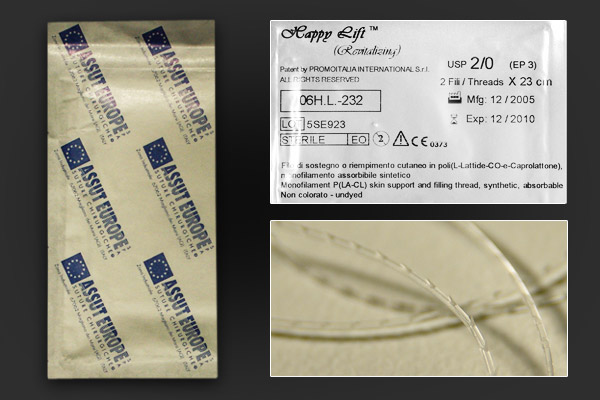 Absorbable suture
Absorbable suture 
Suture structure: smooth or barbed ?
-
We may suspend tissues with two types of suture, the smooth suture and barbed suture. The former are older, with invariable installation, and inaccurate effect, while the latter are recent, with variable installation and precise effect.
-
History -
Smooth suture
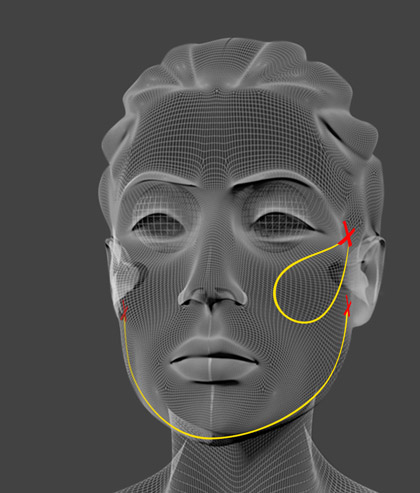 SMOOTH SUTURE can not mobilize the tissues until they have surrounded them, partially or completely. They then form loops, which are anchored by a single highest point on solid tissues (fascia), or form straps when attached at two points. SCHS
SMOOTH SUTURE can not mobilize the tissues until they have surrounded them, partially or completely. They then form loops, which are anchored by a single highest point on solid tissues (fascia), or form straps when attached at two points. SCHS
Long used in surgery, smooth sutures are still used in aesthetics in various locations, including the mid face for deep facelifts.
- Loops and straps from smooth suture have the advantage of being easy to implement, but they also have many disadvantages that have led to their phasing out as barbed suture is improving, being much more logical, adaptable and predictable in their results.
Despite the great services they provide in many areas, we note three main defects against them in aesthetics: the first is the great difficulty in placing them symmetrically, the second is their poor adaptation to areas that are not hemispherical - only cheek approaches this form while the entire face must be lifted - and the third is their tendency to cut the tissue they are supporting by a butter slicer effect, causing pain and dimples that may require removal in a more or less long term.
Known since the '60s, they have been prone to some improvements especially about the needle implementation, the shape is particular. An advanced version of the needle can facilitate the implementation practicing also a wider loop, but it is unclear whether it will slow the decrease in interest in this technique. -
Barbed sutures
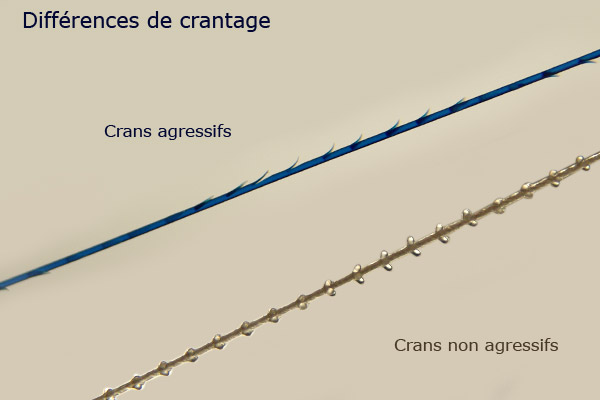 Barbed sutures do not include but pool tissues linearly the tissues thanks to the many small bumps that cover its surface. This one little detail of structure has revolutionized the use of suture.
Barbed sutures do not include but pool tissues linearly the tissues thanks to the many small bumps that cover its surface. This one little detail of structure has revolutionized the use of suture.
There are two types ;
- the mono directional barbed suture
- the bi-directional barbed sutures
The main question is : How to be effective without being aggressive ?
The bi directional barbed suture of suspension are recent (BUNCKE 1997 - SULAMANIDZE 1998) while the smooth loops (GUILLEMAIN Curl Lift 1965) and the one-way barbed suture (ALCAMO 1956) have been described for over half a century. All barbed suture were originally intended to wound closure.
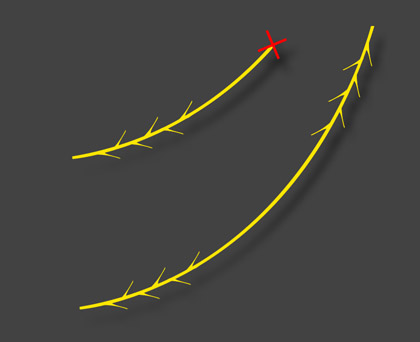 They have changed a lot in 10 years because from short (5-12 cm) and rigid, with aggressive tipped notches, they became very long (35 cm), flexible and extendable, with nonaggressive rounded notches.
They have changed a lot in 10 years because from short (5-12 cm) and rigid, with aggressive tipped notches, they became very long (35 cm), flexible and extendable, with nonaggressive rounded notches.
Each type has a very different method of attaching tissues.
- One way barbed suture, are necessarily fixed by another suture to claim to real lift-up action, like smooth loop sutures.
- The two-way barbed suture non-fixed otherwise than by their own notches, are alone in tissues while "squeezing" them in their center. Depending on their location on the face, they will have or not a real lift up action. (See location of suture).
-
Permanent sutures are mostly made of polypropylene (APTOS ®, UPACTIV ®, and only partially for SILHOUETTE SUTURE ®) material used for over 50 years in permanent deep sutures. Their structure, in this material, may vary for the suture of second generation, with some consequences on the conduct of results (UPACTIV ® - knit Microfiber).
Their diameter is usually 3 / 10 th of a millimetre, but can decrease to 2 / 10 nd (SILHOUETTE SUTURE ®), which improves elasticity, but highly increases the risk of lengthening eventually, detrimental to the outcome.
The third generation permanent suture (SPRING SUTURE ®) is not made of Polypropylene anymore, which is too rigid for old suture, or on the contrary, too prone to distension for the latest knit fibre but is made from a blend of two biocompatible materials in the form of a polyester core sheathed with a silicone rounded notch coating.
They are made of a mixture of polylactic acid and glycolic acid , whose absorption, half-made after 8 months, will be completed after 12. It is assumed that the resorption of the very thin end of notches involves very quickly the disappearance of the main hanging elements, without which the lifting effect can not be obtained.
Though, they are proposed by the manufacturer for 12-18 month length result. « Duration of presence » seems to be a more appropriate term.
It is said that their work extends beyond this period of resorption by the resistance of the cord fibrosis generated by biodegradation. This should be compared to the recorded fact that this diameter of fibrosis has no resistance, and also that this type of fibrosis does not survive the loss of the fibrotic component.
It should be noted that there is a mixed suture, absorbable and permanent (SILHOUETTE SUTURE ®), made of a small diameter permanent propylene suture (2 / 10 th of a millimeter), associated with nodes which block absorbable cones serving as Nontraumatic notches. Persistence of polypropylene after the absorption of these cones requires to classify them in the category of permanent suture... without notches, of which it is the only representative.
Comparison of different sutures's structures (same scale of 4 cm)
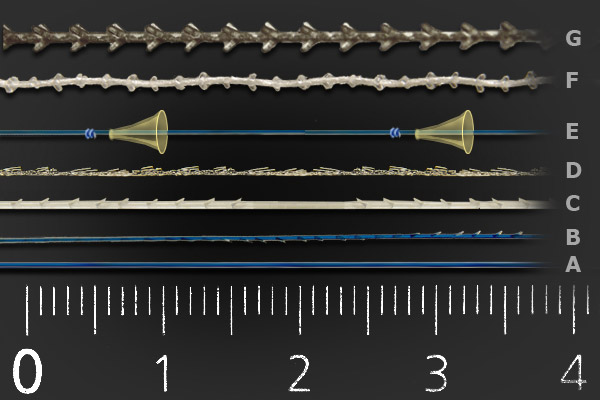 |
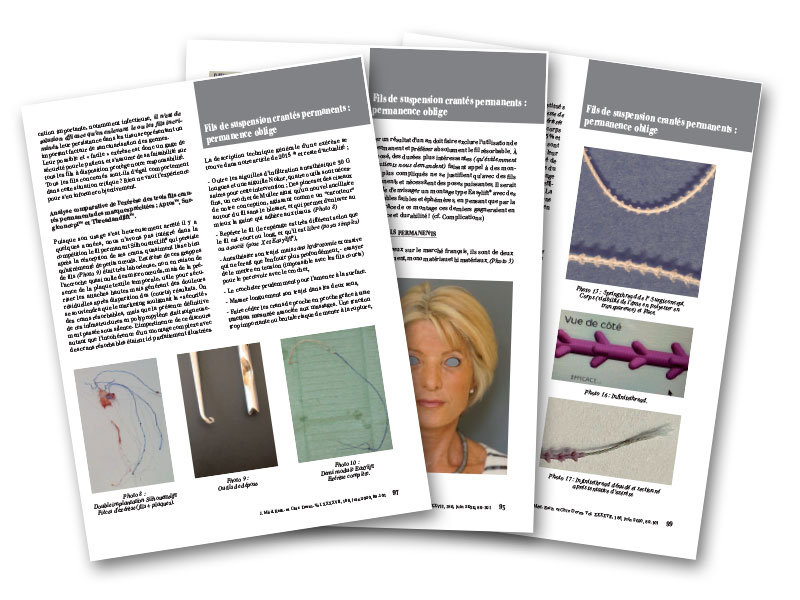 Fils de suspension crantés permanents : permanence oblige (PDF, 2020)
Fils de suspension crantés permanents : permanence oblige (PDF, 2020) 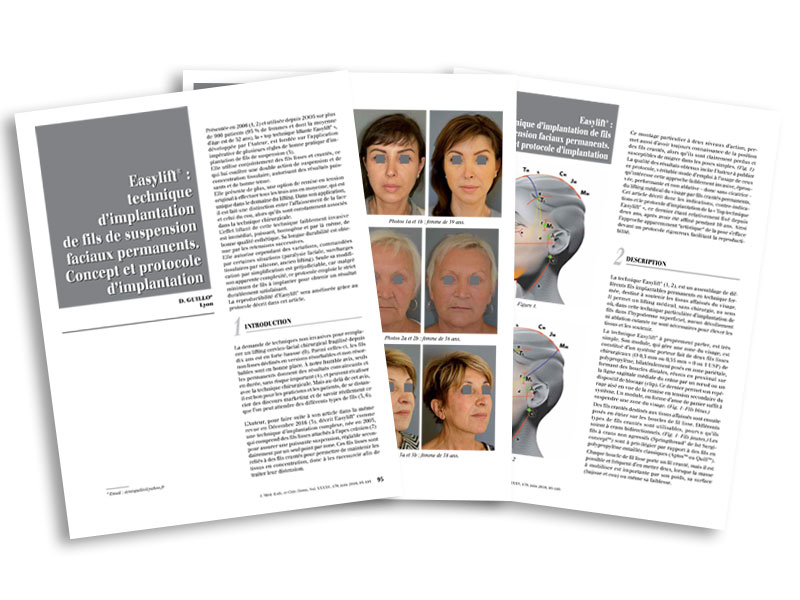 Easylift® : technique d’implantation de fils de suspension faciaux permanents.
Easylift® : technique d’implantation de fils de suspension faciaux permanents. 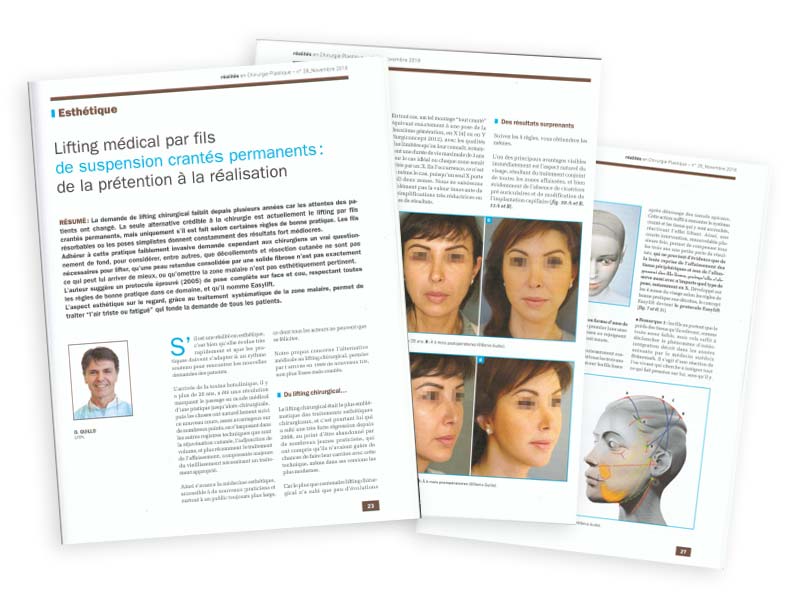 Lifting médical par fils de suspension crantés permanents
Lifting médical par fils de suspension crantés permanents 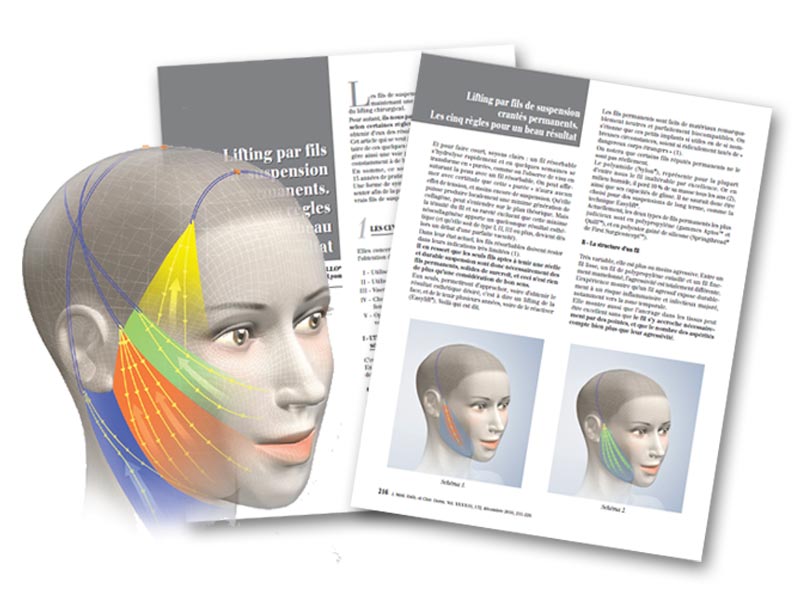 Lifting par fils de suspension crantés permanents
Lifting par fils de suspension crantés permanents 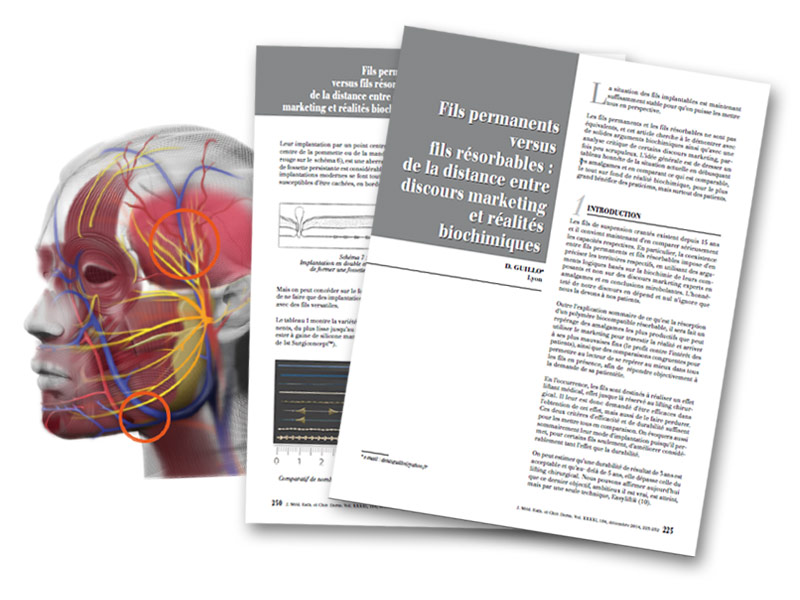 Fils permanents vs fils résorblables : de la distance entre discours marketing et réalités biochimiques
Fils permanents vs fils résorblables : de la distance entre discours marketing et réalités biochimiques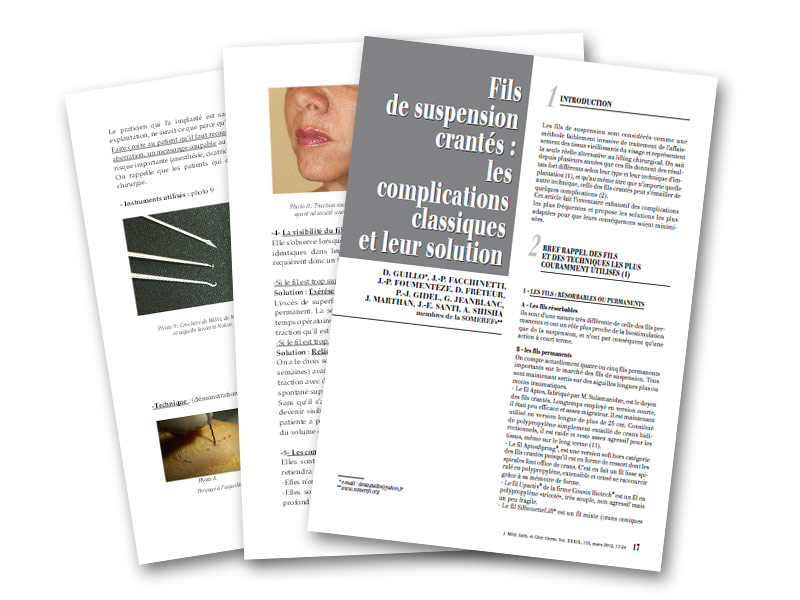 Fils de suspension crantés : Les complications classiques et leur solution.
Fils de suspension crantés : Les complications classiques et leur solution.